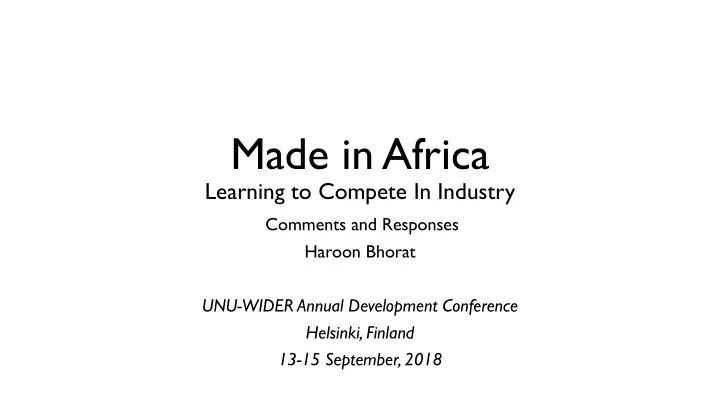

Made in Africa Learning to Compete In Industry Comments and Responses Haroon Bhorat UNU-WIDER Annual Development Conference Helsinki, Finland 13-15 September, 2018
Five Key Observations 1. The Nuances in Africa’s Manufacturing Malaise 2. What about the Natural Resource Sector? 3. Another Lens: Building Economic Complexity Through Capabilities 4. Are we Over-Stating (Under-Stating) the Opportunity in Services (Manufacturing)? 5. The Future African Workforce: The Challenge to Industrialisation
I. Africa’s Manufacturing (& Services) Malaise? Sectoral Productivity and Employment Changes in Africa, 1975 - 2010 • There has been a structural transformation from Agriculture =15.91; t-stat=1.34 MIN 3 into low productivity (but relatively higher than Agric.) jobs 2 in the urban informal sector UTI TRS • High productivity-low BUS 1 CONT employment Natural Resource GOS Sector WRT MAN 0 • No Manufacturing Growth Dynamic -1 AGR • No spillover effects from PES -.1 -.05 0 .05 Manufacturing Change in Employment Share (%) *Note: Size of circle represents employment share in 2010
2. What about the Natural Resource Sector? • In period 2008-2013: Seventeen African Economies have grown at over 5%. Ethiopia 9 • 14 of these 17 ‘African Ghana Lions’ classified as resource-dependent*. Rwanda 8 • Any industrialisation strategy must think about the natural resource Sierra Leone sector (governance, 7 Mozambique Nigeria management of super- Zambia United Republic of Tanzania cycles, Dutch Disease) Uganda Central African Republic Burkina Faso Niger Angola Dem. Rep. of the Congo • To what extent is 6 Chad Congo manufacturing output, really downstream Sao Tome and Principe mining? 5 • Use of natural resource 0 .2 .4 .6 .8 1 Resource Dependence boom revenues? Source: WDI, 2014, UNCTAD (2014), Own Calculations. Evidence? *: The 17 countries are: Ethiopia, Uganda, São T omé and Príncipe, Ghana, Rwanda, Burkina Faso, Tanzania, CAR, Niger, Sierra Leone, Mozambique, Zambia, DRC, Congo, Chad, Angola, and Nigeria.
3. Building Economic Complexity Through Capabilities Pure Manufacturing ECI & GDP p.c. MIC Sample only ,2013 • ‘Substantial African Manufacturing Exporters’ 10 (blue markers) are: SYC GNQ • Mauritius, South Africa, Tunisia, Morocco and Egypt - TUR MEX 9 have higher levels of economic complexity. BWA GAB MYS MUS LBY ZAF BRA CUB NAM • Group of African countries ‘substantial TUN CHN THA DZA 8 SLV AGO CPV exporters’ of manufactures, but lower levels MAR SWZ UKR LKA COG IDN of econ. Dev. (blue markers): EGY PHL IND 7 CIV NGA ZMB VNM CMR STP LSO • Cote d’Ivoire, Kenya, Uganda, T ogo, Malawi and MRT SEN PAK GHA TCD BGD Madagascar. KEN COM BEN TZA BFA SLE MLI ZWE GMB GNB MOZ TGO UGA 6 RWA • Relative to top-performing emerging market LBR GIN ETH NER ZAR MDG MWI countries, Africa’s top manufacturing CAF ERI BDI 5 exporters have lower levels of economic -3 -2 -1 0 1 complexity and hence lower levels of Economic complexity index productive knowledge. Middle income countries Africa - PM/X > 0.2 Africa - PM/C < 0.2 Source: Own calculation using data from The Economic Complexity Observatory (Simoes & Hidalgo, 2011) Notes: 1. The middle income country groups, depicted by the green markers refers to a sample of non-African middle income countries. 2. The blue markers refer to African countries whose pure manufacturing exports as a share of total exports exceeds 20 percent. 3. The red markers refer to African countries whose pure manufacturing exports as a share of total exports is less than 20 percent.
3. Building Economic Complexity Through Capabilities • South Africa’s Product Space, 2015 Platinum Iron ores and Agro-processing Still peripheral, • concentrates and thus no evidence of Chemicals and manufacturing- plastics led structural transformation Machinery and transport Coal Gold Horticulture Source: CID (2018) Notes: Product groupings or clusters are represented by the following colours: Textiles & Furniture (light green); Vegetables, Foodstuffs & Wood (yellow); Stone & Glass (light brown); Minerals (dark brown); Metals (red); Chemicals & Plastics (light purple); Transport Vehicles (dark purple); Machinery (blue); Electronics (turquoise); Other (dark blue).
4. Are we Over-Stating (Under-Stating) the Opportunity in Services (Manufacturing)? • View that convergence through manufacturing exports (the East Asian miracle route) is no longer possible in today’s world economy. • Hence, its more about services and less about manufacturing. • Technical (non-economist) question: Can you build a high-tech services economy without manufacturing capabilities? • Manufacturing output requires the building of transport infrastructure, provision of energy, logistics – a necessary phase of economic development • e.g. Rwanda: Drone production versus delivery of cold stored pasturised milk • On average Services economy is much more skills-intensive than manufacturing: • “With few exceptions, services traditionally have not acted as an escalator sector like manufacturing “ (Rodrik,2014)
5. The Future African Workforce: The Challenge to Industrialisation Population Projections, World and Sub-Saharan Africa: 2015 - 2100 Total Population Working Age Population (Billion) (Billion) % % 2015 2100 2015 2100 Change Change SSA 1.0 3.9 291.62 0.5 2.5 400.00 World 7.3 11.2 53.42 4.8 6.7 39.58 SSA Proportion 13.7% 34.8% - 10.4% 37.3% - (%) Source: Authors’ calculations using the UN World Population Database.
Recommend
More recommend